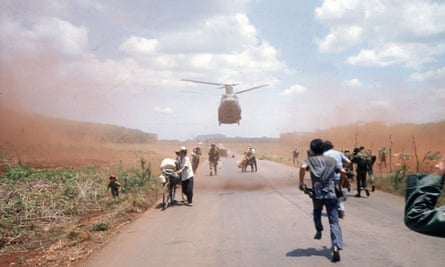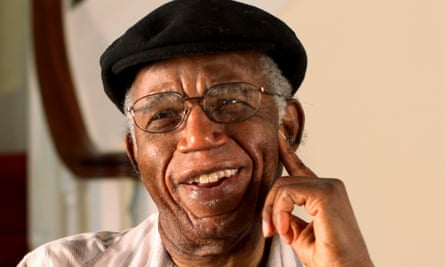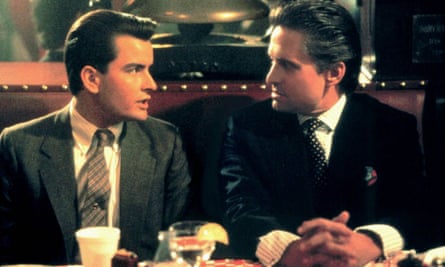In April 1936, three years before his death, WB Yeats received a letter from the writer and activist Ethel Mannin. The 70-year-old Yeats was a Nobel prize-winning poet of immense stature and influence, not to mention Mannin’s former lover, and she asked him to join a campaign to free a German pacifist incarcerated by the Nazis. Yeats responded instead with a reading recommendation: “If you have my poems by you, look up a poem called ‘The Second Coming’,” he wrote. “It was written some sixteen or seventeen years ago & foretold what is happening. I have written of the same thing again & again since. This will seem little to you with your strong practical sense for it takes fifty years for a poet’s weapons to influence the issue.”
Yeats was justified in taking the long view. Written in 1919 and published in 1920, “The Second Coming” has become perhaps the most plundered poem in the English language. At 164 words, it is short and memorable enough to be famous in toto but it has also been disassembled into its constituent parts by books, albums, movies, TV shows, comic books, computer games, political speeches and newspaper editorials. While many poems in Yeats’s corpus have contributed indelible lines to the storehouse of the cultural imagination (“no country for old men”; “the foul rag and bone shop of the heart”), “The Second Coming” consists of almost nothing but such lines. Someone reading it for the first time in 2020 might resemble the apocryphal theatregoer who complained that Hamlet was nothing but a bunch of quotations strung together. Whether or not it is Yeats’s greatest poem, it is by far his most useful. As Auden wrote in “In Memory of WB Yeats” (1939), “The words of a dead man / Are modified in the guts of the living.”

As the world is wrenched out of joint by the coronavirus pandemic, many people are turning to poetry for wisdom and consolation, but “The Second Coming” fulfils a different role, as it has done in crisis after crisis, from the Vietnam war to 9/11 to the election of Donald Trump: an opportunity to confront chaos and dread, rather than to escape it. Fintan O’Toole has proposed the “Yeats Test”: “The more quotable Yeats seems to commentators and politicians, the worse things are.”
Turning and turning in the widening gyre
The falcon cannot hear the falconer;
Things fall apart; the centre cannot hold;
Mere anarchy is loosed upon the world,
The blood-dimmed tide is loosed, and everywhere
The ceremony of innocence is drowned;
The best lack all conviction, while the worst
Are full of passionate intensity.Surely some revelation is at hand;
Surely the Second Coming is at hand.
The Second Coming! Hardly are those words out
When a vast image out of Spiritus Mundi
Troubles my sight: somewhere in the sands of the desert
A shape with lion body and the head of a man,
A gaze blank and pitiless as the sun,
Is moving its slow thighs, while all about it
Reel shadows of the indignant desert birds.
The darkness drops again; but now I know
That twenty centuries of stony sleep
Were vexed to nightmare by a rocking cradle,
And what rough beast, its hour come round at last,
Slouches towards Bethlehem to be born?
The first stanza is a series of punchy declarations about a crisis of authority, almost as if Yeats were an op-ed writer in full thunder. The oracular second stanza asks why this is happening and imagines what might follow the phase of anarchy: the second coming will be a reversal of the first.
Yeats began “The Second Coming” during the tense, eventful month of January 1919. The first world war was barely over and the Russian Revolution, which dismayed him, still unfolding, while another war was brewing on his doorstep. On 21 January, the revolutionary Irish parliament met in Dublin to declare independence while, in a quarry in Tipperary, members of the IRA killed two officers of the Royal Irish Constabulary. The birth of Yeats’s daughter, Anne, in February was also freighted with danger. During her pregnancy, his young wife Georgie Hyde-Lees had been stricken by the Spanish flu that was burning through Europe. Events conspired to put Yeats in an apocalyptic frame of mind.

He found the metaphors to express it via hundreds of automatic writing sessions, during which Georgie convinced her husband that she was channelling the wisdom of “Controls” and “Instructors” from the spirit realm. From these sessions, Yeats constructed an elaborate, world-explaining “System”, which he eventually laid out in bewildering detail in A Vision (1925). Crucial to “The Second Coming” was the symbol of the gyre (a cone or spiral) and Yeats’s conviction that history moved in 2,000-year cycles. The age of Christ (“twenty centuries of stony sleep”) was coming to an end and a new era –– antithetical to progress and reason –– would begin with the birth of the rough beast in Bethlehem.
Early drafts of the poem illustrate Yeats’s dedication to universalising his message, as he deletes specific references to the French Revolution and the first world war and replaces terrestrial images of judges and tyrants with figures from dreams and myths. This “productive vagueness”, says David Dwan, an associate professor of English at Oxford University, is what makes the poem ever-relevant. Evident, too, in the drafts is Yeats’s painstaking refinement of each line. “All things have begun to break and fall apart” is distilled into “Things fall apart”; “The centre has lost” becomes “The centre cannot hold”. The beast that has blandly “set out” for Bethlehem “slouches” instead. In the final version, every phrase has vigour and weight. The poem is built to last.
“The Second Coming” was published in both The Nation and The Dial in November 1920 and then in Yeats’s collection Michael Robartes and the Dancer (1921). Yet it did not attain what Dwan calls its “problematic ubiquity” until some time after the second world war. By 1963, the aphoristic couplet about the best and the worst was enough of a cliche to irritate the critic Raymond Williams. “The lines are regularly used as rhetorical tactics in the defence of anybody’s sanity against anybody else’s enthusiasm,” he complained.

One reason for the poem’s booming popularity was its supporting role in two influential masterpieces. Chinua Achebe’s Things Fall Apart (1958) enshrined it in the vocabulary of African independence. By 1971, the Guardian observed, the title had become “an African catchphrase”. Joan Didion’s essay collection Slouching Towards Bethlehem (1968) had a similar effect in the US at a time of stomach-churning flux. Didion opened her book with the poem because its lines had “reverberated in my inner ear as if they were surgically implanted there … the only images against which much of what I was seeing and hearing and thinking seemed to make any pattern.”
After Achebe and Didion, lines from the poem popped up with growing frequency in coverage of China, India, Africa, Indonesia, Northern Ireland and Britain. There was apparently no geopolitical drama to which it could not be applied. In 2007, after the Brookings Institute called its report on Iraq “Things Fall Apart”, the New York Times claimed: “The Second Coming is fast becoming the official poem of the Iraq war.” You could find similar claims being made regarding the financial crisis, the Arab spring and, now, the age of rightwing populism. In August 2016, as Trump slouched towards Washington, the Wall Street Journal declared: “Terror, Brexit and US Election Have Made 2016 the Year of Yeats”, after the research company Factiva found that phrases from the poem had already notched up more appearances in the press than in any other year in the previous three decades. Since then, the poem has been invoked by Jordan Peterson and Slavoj Žižek, ransacked for anti-Trump song titles by Moby and Sleater-Kinney, recited in the season finale of Alex Garland’s Devs, and quoted six times in parliament.
The post-2016 turn to Yeats is no surprise, because the image of the centre not holding has long made the poem a touchstone for anxious centrists. Shortly before running for president in 1968, Robert F Kennedy warned: “Indeed, we seem to fulfil the vision of Yeats.” In 1979, Labour grandee Roy Jenkins quoted it at the climax of his celebrated Dimbleby lecture about “the radical centre”, a speech that paved the way for the launch of the SDP.
Yeats himself was not exactly SDP material. With his taste for autocracy, contempt for the masses and fascination with fascism (at least in its first decade), he would have been surprised to find his poem deployed as a spur for the defence of liberal democracy. As late as 1934, he privately admitted in reference to Irish politics: “I find myself constantly urging the despotic rule of the educated classes as the only end to our troubles.” The following year, he recalled that when he was a young contrarian in the age of Victorian optimism, “everybody talked about progress, and rebellion against my elders took the form of aversion to that myth. I took satisfaction in certain public disasters, felt a sort of ecstasy at the contemplation of ruin.”
Enough of that youthful appetite for destruction survives in “The Second Coming” for readers to be divided over whether Yeats fears the rough beast or welcomes it. But surely the two emotions are entangled. Just as dystopian authors get a kick out of dramatising their worst fears, great apocalyptic art has a dreadful vitality, its pulse quickening in proximity to catastrophe. The dynamic ambivalence of “The Second Coming”, mingling horror with excitement, explains its embrace by popular culture. Offering the reader mayhem, terror, suspense and a mysterious nemesis, it is a kind of disaster movie for modern civilisation. A lot of money has been made from inspiring ecstasy at the contemplation of ruin.

In pop music, artists as diverse as the Roots, Zomby and Cristina have released records called Things Fall Apart. On television, shows including The West Wing, Battlestar Galactica and Babylon Five have riffed on “The Second Coming”. In the final season of The Sopranos, reading the poem leads an anguished AJ Soprano to attempt suicide, prompting his mother to ask: “What kind of poem is that to teach college students?!”
So many allusions in mainstream entertainment cannot be intended solely for the amusement of their writers. When Gordon Gekko quipped, “So the falcon’s heard the falconer, huh?”, in the film Wall Street (1987), it must have been assumed that more than a few viewers would clock the reference. In Stephen King’s colossal bestseller The Stand (1978), in which a weaponised “superflu” wipes out most of humanity, one character says: “The beast is on its way. It’s on its way, and it’s a good deal rougher than that fellow Yeets [sic] ever could have imagined. Things are falling apart.” Some knowledge is also required to appreciate the parodic final line of Neil Gaiman and Terry Pratchett’s Good Omens (1990), in which the Anti-Christ is seen “slouching hopefully towards Tadfield”.
It would be unwise to claim that “The Second Coming” is more relevant than ever because that has been said so many times before. If it feels especially potent now, perhaps it is because we have become painfully accustomed to the idea that progress is fragile and it is all too easy to fall back. In an age of shocking reversals, Yeats’s theory of historical cycles – “day & night, night & day for ever,” as he once put it – rings true. The only consolation the poem offers is the knowledge that, for one reason or another, every generation has felt the same apocalyptic shudder that Yeats did 100 years ago. That’s why it is a poem for 1919 and 1939 and 1968 and 1979 and 2001 and 2016 and today and tomorrow. Things fall apart, over and over again, yet the beast never quite reaches Bethlehem.
